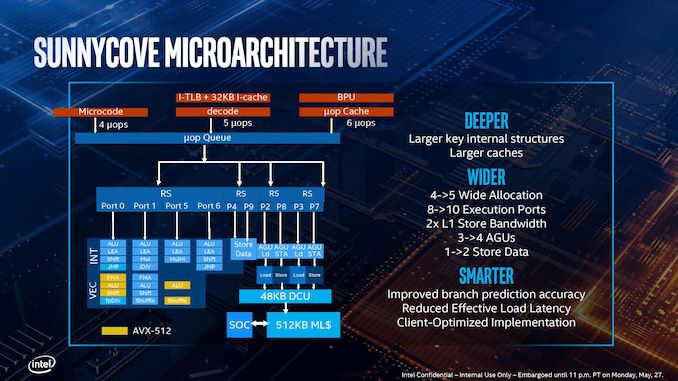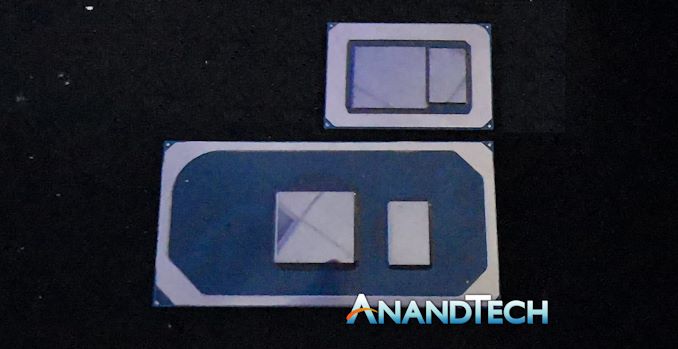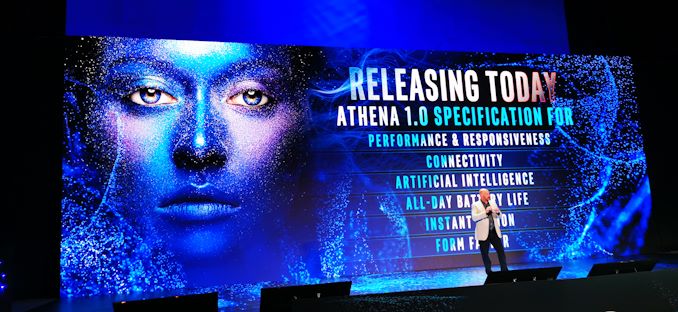Examining Intel's Ice Lake Processors: Taking a Bite of the Sunny Cove Microarchitecture
by Dr. Ian Cutress on July 30, 2019 9:30 AM EST- Posted in
- CPUs
- Intel
- 10nm
- Microarchitecture
- Ice Lake
- Project Athena
- Sunny Cove
- Gen11
Intel’s Ice Lake and Sunny Cove
A Welcome Update, with Questions on Execution
When launching a new mobile product using a new processor design, all the parts have to come together to make it work. This means all of the following:
- The microarchitecture design
- SoC implementation
- Manufacturing
- Co-operation with partners/OEMs
- Time to Market
- Messaging
- Marketing
- Interactions with the press and consumers
- Promotion
- Price
- Competitiveness
Any one of these segments could make or break the next wave of innovation (a key phrase Intel likes to use). With Intel’s 10nm manufacturing process, and the 10th Gen Core 'Ice Lake' design, we’re moving along each of these points in turn, and it is interesting to see what the final reflection will be several years down the line. From our perspective, we now have extensive details on the core and the SoC, and Intel is slowly moving into product phase by the end of the year. We can evaluate what we’ve seen.
The Core and the SoC
Having ‘not another Skylake’ is a huge sigh of relief. With every new microarchitecture update, especially significant ones, we like to see how the power budget is being used and what key structures within the microarchitecture have been improved and expanded upon. The team behind the Sunny Cove core have listed some impressive hard numbers, with doubling the L1 store bandwidth, making significant L1 and L2 cache adjustments, increasing the reorder buffer a whopping +57%, and moving to a 10-port execution unit design. The inclusion of AVX-512 is welcomed by parts of the community for sure, although I expect not as many as Intel would like (this leads onto Intel’s DLBoost strategy, I’ll mention later). Assuming we can get the same +18% IPC metrics that Intel does, this is a great uplift and it will be exciting to see where we go from here.
On the SoC, the big improvements to the graphics and the memory controller are my important ones here. Intel is taking integrated graphics seriously again, with an improved 64 EU design that promises to match AMD’s best at 25W. Intel has improved its memory controller significantly here, now supporting LPDDR4-3733 and DDR4-3200, which helps given that the graphics hardware is always craving memory bandwidth.
Adding Thunderbolt 3 to the SoC is going to help drive adoption in the mobile space, however speaking to a number of press, we think that because TB3 still requires an expensive controller on the device end, that the standard still has that high-cost to entry barrier, even if it ends up being cheaper for host implementation. Until non-Intel TB3 device controllers hit the market, the biggest benefit here is going to be potential support for the USB4 standard. With respect to the Wi-Fi 6 enablement, I’m not so enthused here, as it still requires an additional Intel-only proprietary CNVi module, forcing OEMs to go down an Intel route. If Intel made the CNVi standard open to all, I’d be making a bigger deal about this.
Manufacturing and Time To Market
The fact that Intel is going to end up competing against itself, with Ice Lake-U against Comet Lake-U, is akin to shooting yourself in the foot. Ultimately we expect Ice Lake-U to be focused on the premium market through Intel’s Project Athena, but Comet Lake-U is likely to span from budget to premium as well, especially if it ends up supporting more cores than Ice Lake. Ice Lake should have been a 2017 product, and Intel is only now at a point where it believes its 10nm products are viable for the market, which leads to questions on if the process is even profitable, and how many chips are going to be made available to OEMs – again, because of Project Athena, only key OEM customers going for those premium devices are going to launch initially, tailoring the messaging towards that premium feel.
Questions still surround Intel’s 10nm viability, especially given that the company has promised it is going to be producing high core count Xeons on this process node. Hopefully we can get an update on that.
Ice Lake Messaging, and Project Athena
As mentioned, the whole deal with Whiskey Lake and Comet Lake single thread CPU performance being similar to Ice Lake is going to be a mess. Part of this is down to the messaging for sure, whereby both Ice Lake and Comet Lake are going to be Intel 10th Gen, with Core i7 and Core i5/i3 variants. The only way to distinguish between the two is that Ice Lake has a G in the SKU and Comet Lake has a U, details that some of Intel’s own partners don’t disclose on product pages on websites.
One thing that Intel could lean on is the AVX-512 in Ice Lake, and its DL Boost strategy. Despite AVX-512 being inside Intel’s Xeons, the amount of ‘consumer-grade’ software that uses it is very minimal. By moving it into the consumer platforms, and enabling features like VNNI, Intel wants to drive AI-software solutions into the market. One example we were given was the ability for image software to sort images by what it detects in them – and having this all done locally (and securely) on the CPU, rather than the cloud. If Intel can execute on DL Boost for consumers, it could be a big win, and an easy benefit over the competition.
Turning to Project Athena – I’m all in favor of driving innovation forward and defining specifications that help push new and innovative form factors to enhance the user experience. But as you might have guessed, as it stands, I’m not its biggest fan. The Athena ecosystem is its own closed playground – in order for OEMs to play ball, they have to meet a number of requirements, a sizable chunk of which are only beneficial through Intel-only hardware. For example, Athena devices need Wi-Fi 6, which can be provided by an M.2 module or a CNVi RF chip. Athena devices also need substantial battery life, and the best way to achieve that is by using a CNVi RF option – but Intel is the only one that can make them because the CNVi standard is proprietary.
If an OEM doesn’t want to use Intel’s Wi-Fi 6 solution, then it makes it harder to develop an Athena certified device. It means that OEMs have to play Intel’s game in order to compete in the space. For me, that’s a high entry fee. Sure, the certified devices at the end of day are likely to be great, but if they all have Intel Wi-Fi 6, then where’s the variation? Perhaps I’m a little altruistic here: Intel is trying to create its own certification program and to play by the rules might require investing in Intel-only designed controllers. But I feel that an effort like this works best when there’s competition at every level.
Competition
On a core-to-core level, Intel's recent designs have the following configurations:
| Microarchitecture Comparison | ||||||
| Skylake | Cannon Lake | Sunny Cove* | Zen | Zen 2 | ||
| L1-D Cache |
32 KiB/core 8-way |
32 KiB/core 8-way |
48 KiB/core 12-way |
32 KiB/core 8-way |
32 KiB/core 8-way |
|
| L1-I Cache |
32 KiB/core 8-way |
32 KiB/core 8-way |
32 KiB/core 8-way |
64 KiB/core 4-way |
32 KiB/core 8-way |
|
| L2 Cache |
256 KiB/core 4-way |
256 KiB/core 4-way |
512 KiB/core 8-way |
512 KiB/core 8-way |
512 KiB/core 8-way |
|
| L3 Cache |
2 MiB/core 16-way |
2 MiB/core 16-way |
2 MiB/core 16-way |
2 MiB/core | 4 MiB/core | |
| L3 Cache Type | Inclusive | Inclusive | Inclusive | Non-Inclusive | Non-Inclusive | |
| Decode | 4 + 1 | 4 + 1 | 4 + 1 | 4 | 4 | |
| uOP Cache | 1.5k | 1.5k | 2.25k | 2k | 4k | |
| Reorder Buffer | 224 | 224 | 352 | 192 | 224 | |
| Execution Ports | 8 | 8 | 10 | 10 | 11 | |
| AGUs | 2 + 1 | 2 + 1 | 2 + 2 | 1 + 1 | 2 + 1 | |
| AVX-512 | - | 1 x FMA | 1 x FMA | - | ||
| * Sunny Cove numbers for Client. Server will have different L2/L3 cache and FMA, like Skylake | ||||||
Where AMD has reduced the size of the L1-D cache (to fit in a 4k micro-op cache), Intel has increased it. Both AMD and Intel now sit with 512 KiB L2 caches, although AMD is 4 MiB of non-inclusive cache to Intel's 2 MiB of inclusive cache. Intel has a much larger re-order buffer, and made improvements to its address generation units to help feed the cores. It's becoming ever more important to feed the beast.
Final Thought of the Day
Looking through the Ice Lake and Sunny Cove design, I have to give kudos to Intel’s engineers. The core microarchitecture looks solid, and there is no doubt that Intel will have a raw single thread performance advantage in the mobile space. I’m glad that Intel is taking its graphics solutions seriously again, and between the CPU and GPU, it’s good to see that extra power budget going to good use. I can’t wait to have the hardware on hand.
If you’re listening Intel, please consider the following: I haven’t seen any plans to bring Ice Lake to the desktop, but can we get a quad-core Ice Lake-U at 35W in a desktop processor form factor, for $179?














107 Comments
View All Comments
notashill - Tuesday, July 30, 2019 - link
Are those RAM/SSD targets really "greater than" 8GB/256GB or is it supposed to be "greater than or equal to"?Either way I would love to see an end to companies having >$1000 machines with pathetically low RAM/storage and then charging 500%+ markups to upgrade them to something decent. Like Microsoft's $1200 to go from 4/128 to 16/512.
mkozakewich - Wednesday, July 31, 2019 - link
I can't believe Microsoft has been using 4 GB as their base amount for the last six years. At some point it becomes insulting.repoman27 - Tuesday, July 30, 2019 - link
“Intel uses the ‘U’ designation for anything from 9W to 28W TDP, which covers all the mobile ultra-premium devices.”No they don’t. 9W are Y Series, 15 and 28W are U Series. This is all clearly stated in Intel’s publicly available product briefs for 10th Generation Core processors.
HStewart - Tuesday, July 30, 2019 - link
I be curious for more information on the Y processors - what the performance difference between Y and U. But it looks like these Ice Lake chips are designed for Ultraportable machines and not designed to replace to higher end ones - even like my Dell XPS 15 2in1 - I am really curious about that replacement - it's GPU is probably short lived possibly in updated higher voltage Ice Lake with Gen 11 graphics or new version with Xe graphics. I also have a Dell XPS 13 2in1 with Y processor - I am actually bringing it to meeting today - it is lightweight and does not really need that much power for what I using it for. I think it will be very interesting to compare this new XPS 13 2in1 and the existing XPS 15 2in1 - yes 15 2in1 has faster processor - but it not Ice Lake and that could make a huge difference.Hixbot - Tuesday, July 30, 2019 - link
4.2% annual IPC growth doesn't sound great but it is better than anything we've seen since SandyBridge.Targon - Tuesday, July 30, 2019 - link
And that should make people question the claims about performance increases. Mind you, how much performance has been lost on Intel chips due to the security issues? Intel may be comparing theoretical performance increases, without disclosing the fact that first through 9th generation have actually lost performance since launch due to security mitigations.So, +18% IPC, but -20% due to security mitigations for issues that are still there. Has Intel actually fixed the problems with the memory controller and other problems that allow for Meltdown and the other problems, rather than mitigating around the problem? If a problem has existed since first generation Core processors that turns out to be a design flaw, that also shows that the fundamental core design hasn't changed all THAT much.
rahvin - Wednesday, July 31, 2019 - link
Meltdown and some of the first spectre mitigations are going to be fixed in the hardware. Later spectre variants are probably only fixed in microcode and software.Where that line is drawn is going to be determined by when they froze the physical design for tapeout.
eek2121 - Wednesday, July 31, 2019 - link
I'm not knocking Intel on the IPC growth. If they had an 18% increase, great for them! However, mobile Intel CPUs of any variant (U, HK, Y, etc.) are much slower than their desktop counterparts. My Core i7 2600k absolutely destroys the 6700HK in my laptop. Laptops in general are designed to be low power devices, so performance is never the number one factor in designing a laptop, even on the high end. The only exception to this is the so called 'desktop replacements' that weigh a ton, have desktop class hardware, and basically need to be plugged in to not have the battery die after an hour.That's also the reason I take this announcement with a grain of salt. 18% on mobile is one thing. 18% on the desktop is something else. As I've mentioned to people here and elsewhere, the smaller the process, the harder it is to maintain high clock speeds. Also, from reading certain documentation, it seems that part of that 18% is counting the addition of AVX-512. I could be mistaken though.
erple2 - Wednesday, July 31, 2019 - link
Wow, really? That has not been my experience at all. My 6700hq has generally been (usually significantly) better performing than my 2600k for the vast majority of tasks I've thrown at it.jospoortvliet - Monday, August 5, 2019 - link
Any task that requires sustained compute will of course suffer on thr lower power budget on mobile. But tasks which require short bursts of activity will do better thanks to vastly improved turbo since the 2600k. So depending on what you do your impression might very well be accurate.